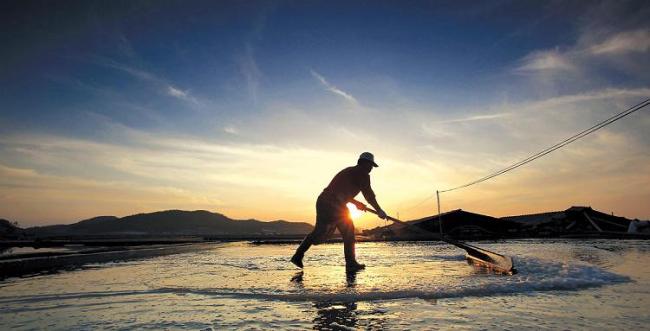
In the far southern villages of Sinan and Yeonggwang in South Jeolla Province, there are endless salt farms glaring with white crystalline under the sizzling sun. They are the so-called salterns, and appear on the UNESCO World Heritage Site Tentative List.
“Salterns are the result of human interaction with the environment and are also an outstanding example of sea water usage. They show the continuity of a living culture in which people have long employed the natural environment to produce items necessary for daily life,” UNESCO says on its website.
“As most salterns are located along the coastline, where banks are built to use tidal flats, harmonious interaction with nature is regarded as essential for salt production. Therefore the wise, scientific use of the environment found in the Korean salterns ― demonstrated by the slope-sided fields used to link the reservoirs to the crystallization ponds and warehouses for the rainy season ― also prove the sites’ integrity, no less their authenticity,” it said.
“Salterns are the result of human interaction with the environment and are also an outstanding example of sea water usage. They show the continuity of a living culture in which people have long employed the natural environment to produce items necessary for daily life,” UNESCO says on its website.
“As most salterns are located along the coastline, where banks are built to use tidal flats, harmonious interaction with nature is regarded as essential for salt production. Therefore the wise, scientific use of the environment found in the Korean salterns ― demonstrated by the slope-sided fields used to link the reservoirs to the crystallization ponds and warehouses for the rainy season ― also prove the sites’ integrity, no less their authenticity,” it said.

South Jeolla Province is the central point for Korean salt production. The sun-dried salt produced from the area accounts for up to 70 percent of the nation’s sun-dried salt production.
“There are many types of salt ― sea salt, rock salt and refined salt. Sea salt is obtained from seawater, through evaporation in shallow pits or basins. Rock salt is the result of the sun drying and crystallizing water in ancient seas, sealed off due to crust movements,” said Kim Joon, a researcher at the Jeonnam Research Institute.
For centuries, sea salt production has been an important activity throughout Korea, and coastal communities developed sophisticated techniques for producing this vital mineral from seawater, he said.
Sun-dried salt, or “cheonilyeom,” contains less sodium than other salts and health experts say it helps prevent gastric diseases. It is used in preparing a wide range of foods including winter kimchi and preservatives.
The salt from Sinan usually reaches the market once the bitterness is removed, which takes about a year, and is known to taste less salty than others.
“Korean sea salt contains a high proportion of organic material. While rock salt and refined salt contain more than 95 percent sodium chloride, sea salt has a lower concentration of sodium chloride at about 85 percent. Sea salt also contains an abundance of various minerals that are beneficial for the body,” Kim said.
“Most people did not know the importance of minerals in the past. In fact, it was thought that because sea salt has less sodium chloride compared to refined salt, sea salt was of poor quality. However, when sea salt started to be commercialized, many people finally came to understand its value,” he added.
According to Kim and his institute, Korean tidal flats contain a high proportion of organic material, and the diverse species in these estuaries help to increase the mineral content, such as calcium, potassium and magnesium, in the salt. Because of this, sea salt is by for the main type used in Korea, where fermented foods are well developed.
The local government has been working to grow the brand image of Sinan and Yeonggwang sun-dried salt, investing 26.8 billion won in refining the logistics process and making the overall production eco-friendly.
The authorities in January also announced a series of plans to create a 1,004-kilometer trail in the areas for eco-tourism, where visitors would be able to walk, ride bicycles or use boats to appreciate the scenery.
“We hope the project can help raise public awareness of the environment, the value of salterns and boost the local economy, too,” Sinan authorities said in a press release.
By Bae Ji-sook (baejisook@heraldcorp.com)
-
Articles by Korea Herald






![[Weekender] How DDP emerged as an icon of Seoul](http://res.heraldm.com/phpwas/restmb_idxmake.php?idx=644&simg=/content/image/2024/04/25/20240425050915_0.jpg&u=)



![[Music in drama] An ode to childhood trauma](http://res.heraldm.com/phpwas/restmb_idxmake.php?idx=644&simg=/content/image/2024/04/25/20240425050929_0.jpg&u=)








![[Herald Interview] Mistakes turn into blessings in street performance, director says](http://res.heraldm.com/phpwas/restmb_idxmake.php?idx=652&simg=/content/image/2024/04/28/20240428050150_0.jpg&u=20240428174656)
